LA CALOPSITE
4 posters
Page 1 of 1
 LA CALOPSITE
LA CALOPSITE
Nymphicus hollandicus: Calopsitta
Altri nomi: Ninfico, Cacatua delle ninfee

Stato di conservazione:

Classificazione scientifica
Dominio: Eukaryota
Regno: Animalia
Sottoregno: Eumetazoa
Superphylum: Deuterostomia
Phylum: Chordata
Subphylum: Vertebrata
Superclasse: Tetrapoda
Classe: Aves
Sottordine: Psittaciformes
Famiglia: Cacatuidae
Sottofamiglia: Nymphicinae
Genere: Nymphicus (Wagler, 1832)
Areale: Habitat naturale: Australia

La Calopsitta o Calopsite (Nymphicus hollandicus Kerr, 1792), è un uccello della famiglia degli Cacatuidi. È l'unica specie appartenente al genere Nymphicus.
Descrizione

Le sue dimensioni sono abbastanza ridotte, tra i 30 e i 32 cm; di forma allungata, con una lunga coda e il tipico ciuffo sulla fronte, il colore ancestrale è in prevalenza grigio scuro ad eccezione della faccia e del ciuffo di colore giallo con la tipica macchia tonda e rossa all'altezza della guancia, ali con un'evidente macchia bianca lungo il bordo esterno e la coda più chiara rispetto al resto del corpo; la femmina si distingue dal maschio per il colore grigio che persiste anche in faccia e nel ciuffo, la macchia rossa leggermente più piccola e dal colore meno intenso e la coda barrata di giallo. Il maschio presenta il ciuffo più sviluppato e di colore giallo (mentre nella femmina è piccolo e grigio) così come il colore della testa, che nel maschio presenta il giallo più diffuso e abbondante.
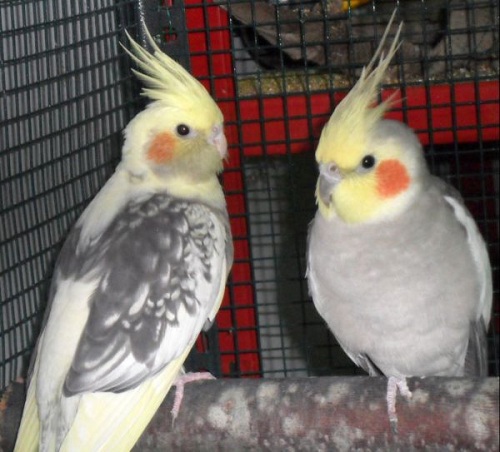 Lixi e Calo
Lixi e Calo
Anche se può sembrare grande rientra nei pappagalli di piccola taglia, per due caratteristiche, voce non troppo molesta e becco piccolo.
Ma esistono altre varietà nelle quali il dimorfismo sessuale è meno evidente: il lutino di colore prevalentemente giallo e bianco, il cinnamon che presenta una scala di grigi più chiara, il perlato dalle macchie gialle o bianche sparse su tutto il corpo, il facciabianca dalla colorazione bianca della faccia anziché gialla, il facciagialla, il pastello, l'oliva, il silver e tanti altri.

Alimentazione

La calopsite è facile da alimentare in quanto granivora e di poche pretese, si utilizza la miscela di semi per cocorite oppure quella per esotici ovvero un mix di scagliola, avena, semi di girasole (sconsigliati da diversi allevatori poiché essendo ricchi di olii e grassi danneggiano, se mangiati in abbondanza, il fegato dell'animale). Adorano le spighe di panico ed è bene fornigliene una alla settimana per integrare la loro alimentazione.

Poiché in natura assumono semi a differenti stati di maturazione (che non sono assolutamente nutrizionalmente paragonabili al comune misto di semi secchi) meglio aggiungere anche alimenti di origine diversa ed alternativi ai semi, come la pasta ed il riso cotti che dimostrano di gradire molto, il mais immaturo e maturo lesso, foglie verdi di vegetali quali cavoli, varietà diverse di insalate e fagiolini verdi, ma anche altre verdure (carota; cetriolo; peperoni e peperoncini, anche piccanti; cicoria; rucola).
Ottime pure le erbe prative, facilmente trovabili nei prati e lungo i fossi e da somministrare dopo essere state attentamente lavate, come la piantaggine maggiore (Plantago maior), il centocchio bianco (Stellaria media), il tarassaco (Taraxacum officinalis), spighe di piantaggine.

La frutta fresca è ricca di vitamine e sali minerali (albicocca; arancia; banana; cocomero; frutti di bosco; kiwi; mandarino; mela; melone; mora di gelso; pera; prugna; uva).
I legumi sono un’importante fonte di proteine: i piselli e i fagiolini possono essere dati crudi, mentre i fagioli, i ceci e la soia devono essere ben cotti. Utilizzare preferibilmente legumi biologici, non in scatola; quelli secchi vanno messi nell’acqua per almeno 6 ore e poi bolliti a fuoco basso per circa 45 minuti. La soia deve cuocere per circa 90 minuti.
Nel periodo dell'alimentazione dei piccoli è necessario aggiungere alla dieta panico germinato, pastone all'uovo, pane in zuppato e tarme della farina, pezzetti di pane raffermo, cereali bolliti, cibo in crocchette estruse per pappagalli di piccola taglia, l'uovo sodo.
 Cassiopea
Cassiopea
I semi germinati sono ricchi di vitamine e possono essere quasi comparati alla verdura. Le vitamine quali la E o la A e la C vengono moltiplicati allorché i grani germogliano. Costituiscono dunque un alimento molto utile. Grazie alle vitamine e alla loro digeribilità, questi grani germogliati possono essere donati durante periodo d'allevamento o per lo svezzamento dei piccoli. Molto ricchi in vitamina E possono essere distribuiti prima del periodo di riproduzione.

Si possono offrire in quantità limitata: Yogurth; formaggio magro; cereali, pasta e riso bolliti (meglio se integrali). La frutta secca: (noci, mandorle, noci del Brasile, anacardi, nocciole, macadamia, arachidi, pinoli, pistacchi, arachidi) è una buona fonte di proteine, fibre, magnesio, zinco, selenio, rame, potassio, fosforo, biotina, riboflavina, niacina, calcio e di vitamina E. E’un alimento sano e importante anche dal punto di vista psicologico, perché i pappagalli sono naturalmente predisposti ad aprirla per estrarne il contenuto.
Contiene circa il 50% di grassi e va fornita con moderazione.

Sono da evitare: gli omogeneizzati per bambini, il miele se non diluito con acqua e bollito a fuoco basso per circa 30 minuti (per il rischio di contaminazione da spore di botulino).
I pappagalli NON devono mangiare: un eccesso di alimenti grassi, cibi conditi, zuccheri e marmellate, fritti, alimenti e bevande alcoliche o che contengono caffeina, avocado, caco (cachi), noccioli di pesco, prugne, albicocche, ciliegio (contengono glicosidi cianogenetici che se ingeriti si convertono in cianuro), latte (non sono in grado di digerire lattosio), gusci d’ uova (o solo se disinfettati, quindi bolliti per almeno 40 minuti), parti verdi di germogli delle patate. Anche certi tipi di vegetali possono essere nocivi per questi e tante altre specie di pappagalli, qui di seguito vi è una lista degli alimenti nocivi: Avocado, Alloro, Clematide, Colocasia, Croton, Dieffenbachia, Digitale, Euforbia, Falsa acacia, Filodendro, Fitolacca, Lupino, Mughetto, Oleandro, Prezzemolo, Ricino, Rododendro, Tabacco, Tasso e Vite del Canadà.Anche alcuni rami delle piante appartenenti alla famiglia dei Prunus (albicocco, ciliegio, pesco, susino) sono velenosi per loro. Assolutamente vietato il cioccolato potenzialmente mortale.
Purtroppo non sempre la calopsite accetta alimenti cosi vari. Per abituarla ad una alimentazione sana, dobbiamo mettere a sua disposizione i vari tipi di alimenti sin da quando inizia lo svezzamento. La sua curiosità la porterà ad assaggiare un po’ di tutto ed accettare quanto offerto come alimento gradito.
Vita

In stato di cattività vive generalmente un'età che va dai 15 ai 20 anni, anche se talvolta vive circa 10-15 anni. Vi sono state segnalazioni di esemplari vissuti più di 30 anni; il più vecchio dichiarato è vissuto ben 35 anni.Come nell'uomo, dieta ed esercizio fisico sono spesso i fattori principali che determinano la lunghezza della loro vita.
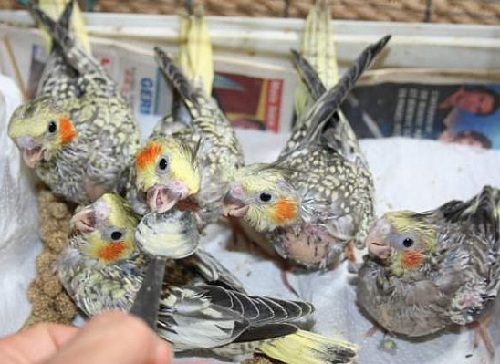
Riproduzione
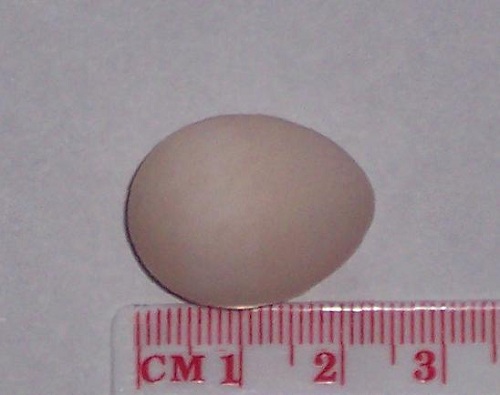
In natura si riproduce dopo la stagione delle piogge, in cavità all'interno degli alberi di eucalipto, in cui la femmina depone dalle 5 alle 7 uova di colore bianco e che cova con l'aiuto del maschio. L’incubazione (cova) dura circa 18/21 gg. Durante il dì il maschio si occupa della cova mentre la notte tale compito è svolto dalla femmina. I pulli lasciano il nido dopo circa 5 settimane ma dipendono ancora dai genitori per altre 2 settimane circa. In cattività non presenta difficoltà: di norma non esiste incompatibilità di carattere, non necessitano di particolari alimenti per allevare la prole, poiché come tutti i pappagalli grazie a delle ghiandole poste sotto il collo, producono un secreto vischioso denominato "latte di pappagallo". La coppia tenderà a continuare a riprodursi tutto l’anno se posta in condizioni ottimali, ma è bene non superare le 2 o 3 cove per non affaticarli troppo.

Il nido deve essere di dimensioni adeguate: ne esistono alcuni sviluppati in orizzontale altri in verticale.Per esempio un nido sviluppato in verticale dovrà essere alto 30/40cm, con una base di almeno 20x20 e con un foro di entrata dal diametro di 7 cm e tetto apribile.
È importante anche inserire un adeguato strato di trucioli per avvolgere delicatamente l’uovo.
I piccoli vengono alimentati dai entrambi i genitori e solitamente escono dal nido attorno alle tre – quattro settimane di vita.
Nonostante riescano da subito a mangiare da soli, il maschio continuerà ad alimentarli per un breve periodo fino a quando non avranno raggiunto una completa autonomia.
Distribuzione e habitat

È nativo solo in Australia dove si trova in gran parte nelle zone aride o semi-aride del paese, ma sempre in prossimità dell'acqua. In gran parte nomade, la specie si sposta in grossi banchi visibili anche a grandi distanze, e quando trova un territorio ricco di cibo vi staziona per un certo periodo ma poi riprende i suoi viaggi. Si possono trovare generalmente a coppie o a piccoli gruppi, talvolta si trovano centinaia di stormi intorno ad un unico corpo d'acqua. Sono assenti nei terreni più fertili a sud-ovest e sud-est del paese, nei deserti occidentali australiani e nella penisola di Capo York. Sono l'unica specie di Cacatuidae a potersi riprodurre alla fine del primo anno.
In cattività
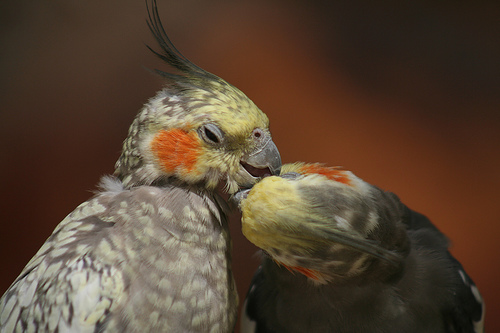
A differenza degli altri cacatua, il cui commercio è regolamentato, la calopsitti non vengono più prelevate in natura e sono di libero commercio. Come qualsiasi altro pappagallo sono uccelli che soffrono moltissimo la solitudine e sarà pertanto necessario allevarle in coppia. La possibilità di alloggiarle in una stanza della casa in cui abbiano la possibilità di stare a contatto con le persone farà emergere la loro natura tranquilla e docile.
Ormai è il pappagallino più diffuso dopo le cocorite, ha le dimensioni di un grosso piccione, apprezzato come uccello ornamentale si adatta facilmente alla vita in casa, divenendo in alcuni casi estremamente socievole, la sua voce consiste in un cicaleccio, che però a seconda delle circostanze ( paura, aggressività, vista di un simile) può trasformarsi in un fischio di richiamo forte e pungente. E' l'ideale per i principianti. Intelligente, curioso, si può insegnare loro qualche piccolo esercizio di abilità o a ripetere qualche parola, si lega molto a chi la accudisce e ama partecipare alla vita quotidiana, magari mangiando a tavola assieme.
Può convivere senza problemi con altri volatili, siano essi psittaciformi (pappagalli) o meno in quanto è innocuo non disturba e non si lascia importunare.
Un esempio di coabitazione sicura è quella con cocorite e canarini.
tre diversi uccelli che vivono bene insieme senza problemi, purché l’alloggio sia sufficientemente ampio (voliera)

L’ alloggio.
Le Calopsitte amano gli ampi spazi, perciò è consigliabile ospitarle in ampie voliere all’esterno, possibilmente su fondo naturale. Sono uccelli che si nutrono prevalentemente a terra e negare la possibilità di manifestare i comportamenti tipici della ricerca di cibo al suolo si traduce in una limitazione comportamentale, causa prima dell’insorgenza di sofferenze psichiche.
La misura minima della larghezza è di 80 cm, , ma più grande è lo spazio meglio è.
La gabbia deve essere di acciaio (zinco, piombo e rame sono materiali tossici). Anche il rivestimento di vernice può causare avvelenamento, se viene asportato con il becco e ingerito. La gabbia va arredata con diversi posatoi, possibilmente di legno naturale, di diametro variabile, per favorire una buona ginnastica delle zampe e prevenire lesioni dei piedi; il diametro medio dei posatoi deve essere tale da consentire alla zampa di circondarli senza che le dita opposte arrivino a toccarsi.

MUTAZIONI (dal sito www.animalinelmondo.it/topic/18876-mutazioni-calopsitta/)

ll colore nelle Calopsitte deriva da due pigmenti:
• Melanina: è responsabile del colore grigio nei soggetti normali. E’ presente anche negli occhi, nel becco e negli arti. Alcune calopsitte però possono presentare becchi e arti più scuri di altri. La mutazione Lutino consiste invece in una completa mancanza di melanina. E’ per questo che gli occhi appaiono rossi, a causa dei vasi sanguigni, e che gli arti e il becco sono più chiari. La melanina è il colore più forte e copre i lipocromi quando entrambi sono presenti.
• Lipocromi: sono responsabili del colore giallo della faccia e della coda e del colore arancione nel disegno delle guance. Quando i maschi maturano il pigmento melaninico nella faccia diventa più debole permettendo ai lipocromi di diventare visibili mentre nella coda l’aumento della melanina fa in modo che la coda presenti un colore più solido. La mutazione Faccia bianca manca dei lipocromi, perciò la faccia bianca non presenta ne’ giallo ne’arancione, che sono sostituiti dal bianco.
Mutazioni Dominanti
Le mutazioni dominanti sono uniche in quanto richiedono solo uno dei genitori per produrre la mutazione nella loro discendenza. Un soggetto a singolo fattore dominante ha un cromosoma X che contiene la mutazione. Un soggetto a doppio fattore dominante ha due cromosomi X, quindi solo i maschi possono essere a doppio fattore (questo perché negli uccelli sono i maschi ad avere i cromosomi sessuali uguali, XX o meglio ZZ, e non come negli esseri umani in cui è la donna ad averli uguali).
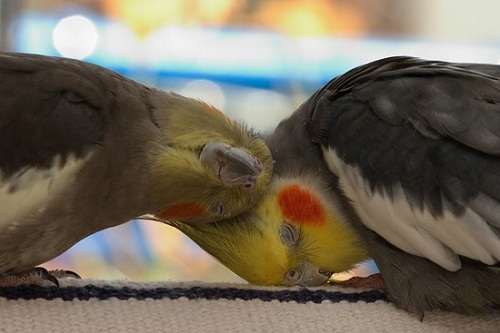
Diluito
E’ una mutazione che è dominante nei confronti delle altre mutazioni, e produce un grigio argento o un grigio più chiaro (del grigio ancestrale). La più ovvia differenza tra il Dominate e il Recessivo è che il dominante ha occhi scuri mentre quello recessivo li ha rossi. Gli uccelli possono portare il gene dominante su uno o su entrambi i cromosomi, e l’effetto colorazione sarà più pronunciato negli uccelli a doppio fattore.
Guancia gialla dominante
E’ una mutazione molto simile alla mutazione sesso-legata Guancia gialla. Gli individui che possiedono questa mutazione hanno una tinta arancione più debole, forse a causa di un doppio fattore, ma più chiara del giallo-arancione del disegno delle guance di un soggetto Pastello. I disegni delle guance di un soggetto a fattore singolo sono gialli.
Grigio normale
E’ il colore da cui sono derivate tutte le mutazioni esistenti ed è il colore grigio delle calopsitte selvatiche australiane. I maschi hanno penne grigio scuro sull’intero corpo, ad eccezione delle barre bianche sulle ali, della faccia gialla e del disegno arancione acceso delle guance. Le giovani calospitte di entrambi i sessi assomigliano molto alle femmine: la faccia è grigia con guance di un arancione opaco, le penne della coda hanno una barratura bianca o gialla sul lato inferiore. Se sono presenti alcune penne gialle o bianche sul collo o sul capo di un individuo grigio normale (ancestrale), ciò significa che la calopsitta ha un gene per la mutazione recessiva Pezzato.
 maschio
maschio
 femmina
femmina
Mutazioni Recessive
Per ottenere un pullo che presenti una mutazione recessiva, entrambi i genitori devono avere la mutazione o fenotipicamente (ovvero la si può vedere a occhio nudo, nel piumaggio dell’uccello) o genotipicamente (ovvero è presente nel genoma ma non si manifesta nell’aspetto esteriore, l’individuo è cioè portatore). Le femmine possono essere portatrici di una mutazione recessiva, ma non di una mutazione sesso-legata. Ad esempio, per produrre discendenza Faccia bianca entrambi i genitori devono per lo meno essere portatori Faccia bianca. Se un genitore non contiene geni Faccia bianca (e l’altro invece sì), la discendenza sarà portatrice del gene Faccia bianca ma nessuno dei pulli mostrerà la mutazione esteriormente.
Pezzato
I pezzati si trovano quando i colori standard del corpo sono sostituiti da giallo o bianco in varie gradazioni. Quando i Pezzati sono giudicati il grado di simmetria e la chiarezza dei segni distintivi sono importanti. Idealmente, un pezzato desiderabile ha una maschera pulita, libera da penne grigie o cannella, coda pulita e un perfetto bilanciamento dei segni distintivi. Un pezzato con penne nere sulla faccia è chiamato Pezzato faccia sporca (Dirty faced Pied). I Pezzati sono conosciuti anche per avere un piumaggio più spesso sul corpo. La mutazione nasce perché i livelli di melanina sono differenti sulle penne degli uccelli.
I pezzati appaiono in tre differenti varianti:
Il Pezzato chiaro (Light Pied) è quello in cui l’uccello è grigio o cannella e molte aree del corpo sono gialle, o bianche per Pezzati faccia bianca.
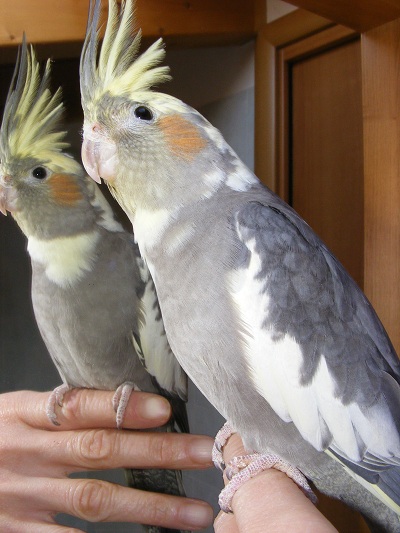 Cassiopea
Cassiopea
Il Pezzato scuro (Heavy Pied) è per lo più un uccello giallo o bianco con del grigio o del cannella ancora visibile su petto e schiena. I più belli hanno petto e faccia liberi dai colori più scuri. Molte persone chiamano le calopsitte che mostrano esigui segni grigi o cannella Pezzato a rovescio (Riverse Pied).

Il Pezzato pulito (Clear Pied) assomiglia molto al Lutino ma ha occhi e arti scuri o colorati normalmente. Si possono osservare una o due penne scure sulla schiena. Possono essere confusi col Lutino e non sono così comuni. Hanno il vantaggio di non avere la zona implume che è presente nei Lutini.
Faccia bianca
Colore grigio carbone, mancanza dell’arancione sulle guance e dei pigmenti gialli. La mutazione Faccia bianca presenta la mancanza di tutti i lipocromi. I maschi adulti maturi portano una faccia bianca invece della maschera gialla indossata dalle altre varietà. Alcune tra le più belle combinazioni sono: Perlato Faccia bianca, Perlato Cannella Faccia bianca, Pezzato Faccia Bianca e Pezzato Cannella Faccia bianca.
 maschio
maschio
 femmina
femmina
 silver maschio
silver maschio
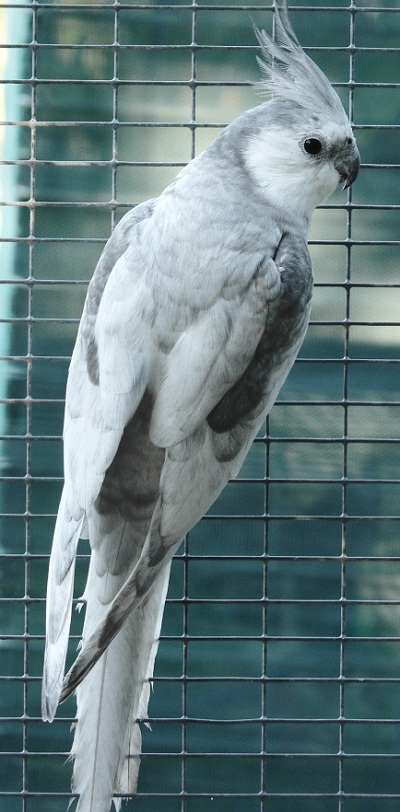 spangle maschio
spangle maschio
Fallow
L’aspetto marroncino (o cannella chiaro) lo fa assomigliare al Cannella, ma con una più pronunciata soffusione gialla e occhi rossi a causa di minor melanina. La calopsitta Fallow, pur assomigliando molto ad una calospitta Cannella, si distingue per l’intensità un po’ diluita del colore. I Fallow hanno occhi rossi, becco e arti rosati.

Pastello
La mutazione Pastello può essere combinata con ciascuna delle altre mutazioni per ottenere bellissimi risultati. Le calopsitte Pastello appaiono simili alle loro controparti naturali, ma le parti gialle, arancioni, marroni e grigie sono un po’ più addolcite. Di qui il nome, pastello. La più ovvia differenza è il colore delle guance, da arancione a giallo aranciato.
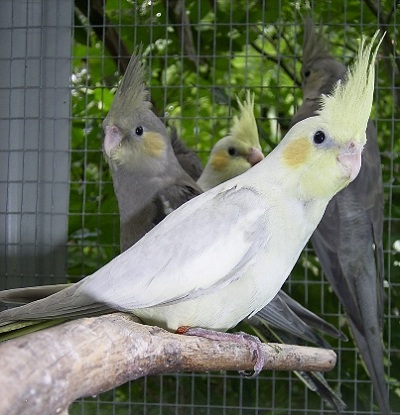 pastello silver
pastello silver
 pastello silver
pastello silver
Oliva
Questa mutazione è anche chiamata Smeraldo, Spangle o Giallo soffuso. Questa mutazione è difficile da descrivere e bisogna osservarla. Il termine Smeraldo o Oliva può induce un po’ in errore. Le calopsitte non hanno alcuna pigmentazione verde, cosicché non possono essere realmente verdi. La combinazione di giallo e grigio insieme alla giusta luce fanno apparire questo uccello verde. Può essere meglio descritto come una combinazione di piccole aree con colori differenti che variano dai gialli ai grigi.


Diluito recessivo
Questa mutazione è una versione grigia diluita o argento del grigio normale. Gli uccelli hanno occhi rossi, becco e arti rosati. I maschi spesso possiedono una faccia giallo carico e guance di un arancione squillante nella maturità. Le femmine mantengono la loro colorazione immatura e le barrature nel sottocoda.
Mutazioni sesso-legate
Le mutazioni sesso-legate sono trasportate sul cromosoma X. I maschi hanno due cromosomi X mentre le femmine hanno un cromosoma X e un cromosoma Y. Perché queste mutazioni siano visibili, esse devono essere portate da entrambi i cromosomi X nel caso dei maschi e dal cromosoma X nel caso delle femmine. Le femmine non possono essere portatrici della mutazione sesso-legata perché se la mutazione è sul loro cromosoma X, allora è visibile. Così, ciò che tu vedi è ciò che hai nel caso di una mutazione sesso-legata in una femmina. Un maschio è portatore quando solo uno dei due cromosomi porta la mutazione.
Lutino
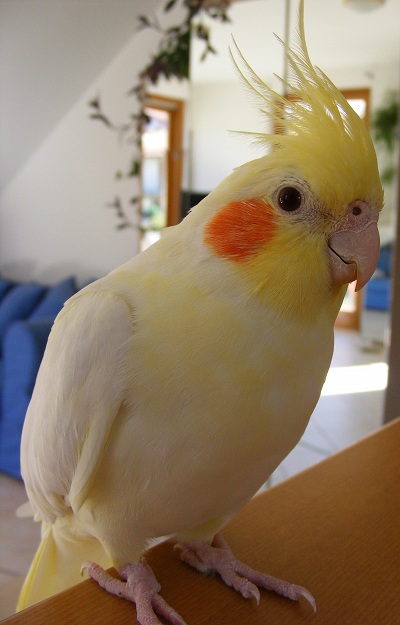 Squikky maschio
Squikky maschio
Il Lutino è un uccello bianco con guance arancioni, pigmenti gialli, arti rosati e occhi rossi. Molti individui variano da una colorazione giallo chiaro ad una giallo scuro su parti più o meno estese del corpo. Alcune volte può esserci una zona implume dietro la cresta. Questa può capitare durante lo sviluppo della mutazione. Il Lutino ideale non ha zone implumi. E’ molto difficile distinguere i maschi maturi dalle femmine. Una combinazione comune è la femmina Perlata Lutino dove si ha del giallo perlato sulle ali e sul dorso.
 lutino cinnamono perlato
lutino cinnamono perlato
 lutino perlato
lutino perlato
 lutino pezzato
lutino pezzato
Cannella
Questa mutazione prende il nome dal colore della cannella che è stato descritto come un colore marroncino grigiastro o un colore cacao. Non si dovrebbe vedere alcun grigio e si dovrebbe notare una tinta giallognola sulle penne. Il colore grigio in un soggetto ancestrale è prodotto dal pigmento melaninico che nel Cannella è ridotto. Alcune femmine possono avere più giallo (lipocromi) sulla faccia rispetto ai soggetti ancestrali.
Il maschio Cannella sviluppa una faccia giallo brillante (conosciuta come maschera) e guance arancione acceso prima della sua prima muta. I giovani e le femmine Cannella mantengono il loro arancione opaco sulle guance, e la loro maschera non diventa gialla; hanno barrature gialle o bianche nel sottocoda.
 maschio
maschio
 femmina
femmina
 cann. perlato maschio
cann. perlato maschio
Perlato

Questa mutazione presenta merlettature o macchie colo perlaceo sul giallo o sul bianco di dorso, nuca e ali. I Perlati gialli spesso sono chiamati Perlati dorati (Golden Pearls). I Perlati bianchi sono chiamati anche Perlati argento (Silver Pearls). Il perlato in un Faccia bianca è sempre bianco. Le merlettature devono essere estese e consistenti. Possono esserci piccoli segni bianchi o gialli sul petto su quei soggetti più intensamente “disegnati”. Tipicamente i maschi adulti perlati perdono la loro perlatura dopo la loro prima muta a causa dei cambiamenti ormonali che avvengono quando maturano. Nonostante ciò, alcuni soggetti mantengono un certo grado di perlatura.
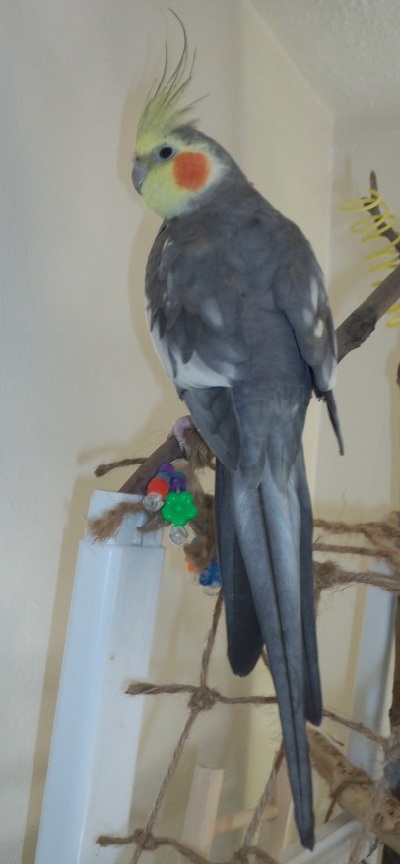 Tsuka maschio
Tsuka maschio
 Dally femmina
Dally femmina
 perlato pezzato
perlato pezzato
Guancia gialla
E’ una delle più recenti mutazioni ed è unica in quanto, di questa mutazione, c’è una versione sesso-legata e una versione dominante. Dove un soggetto ancestrale ha guance arancioni, il soggetto Guancia gialla le ha gialle. Le guance del Guancia gialla dominante sembrano essere un po’ più arancioni che non quelle della versione sesso-legata. Quando si allevano Guancia gialla è importante non allevare mai dominati con sesso-legati. Ci vogliono anni di test di allevamento per determinare quale sarà realmente la discendenza. Inoltre si raccomanda di non allevare Guancia gialla con i Faccia bianca.

Platino
E’ stata vista in Australia. In generale dorso, ali e coda sono di un grigio fumo brillante, con le ali che spesso sono quasi grigio-marroni. Le ali e la coda sono sempre di un colore più scuro delle altre penne. Le piume del sottocoda in un maschio adulto sono di un color marrone cioccolato; becco e arti sono di un colore chiaro.

I nostri pet ...
Altri nomi: Ninfico, Cacatua delle ninfee

Stato di conservazione:

Classificazione scientifica
Dominio: Eukaryota
Regno: Animalia
Sottoregno: Eumetazoa
Superphylum: Deuterostomia
Phylum: Chordata
Subphylum: Vertebrata
Superclasse: Tetrapoda
Classe: Aves
Sottordine: Psittaciformes
Famiglia: Cacatuidae
Sottofamiglia: Nymphicinae
Genere: Nymphicus (Wagler, 1832)
Areale: Habitat naturale: Australia

La Calopsitta o Calopsite (Nymphicus hollandicus Kerr, 1792), è un uccello della famiglia degli Cacatuidi. È l'unica specie appartenente al genere Nymphicus.
Descrizione

Le sue dimensioni sono abbastanza ridotte, tra i 30 e i 32 cm; di forma allungata, con una lunga coda e il tipico ciuffo sulla fronte, il colore ancestrale è in prevalenza grigio scuro ad eccezione della faccia e del ciuffo di colore giallo con la tipica macchia tonda e rossa all'altezza della guancia, ali con un'evidente macchia bianca lungo il bordo esterno e la coda più chiara rispetto al resto del corpo; la femmina si distingue dal maschio per il colore grigio che persiste anche in faccia e nel ciuffo, la macchia rossa leggermente più piccola e dal colore meno intenso e la coda barrata di giallo. Il maschio presenta il ciuffo più sviluppato e di colore giallo (mentre nella femmina è piccolo e grigio) così come il colore della testa, che nel maschio presenta il giallo più diffuso e abbondante.
 Lixi e Calo
Lixi e CaloAnche se può sembrare grande rientra nei pappagalli di piccola taglia, per due caratteristiche, voce non troppo molesta e becco piccolo.
Ma esistono altre varietà nelle quali il dimorfismo sessuale è meno evidente: il lutino di colore prevalentemente giallo e bianco, il cinnamon che presenta una scala di grigi più chiara, il perlato dalle macchie gialle o bianche sparse su tutto il corpo, il facciabianca dalla colorazione bianca della faccia anziché gialla, il facciagialla, il pastello, l'oliva, il silver e tanti altri.

Alimentazione

La calopsite è facile da alimentare in quanto granivora e di poche pretese, si utilizza la miscela di semi per cocorite oppure quella per esotici ovvero un mix di scagliola, avena, semi di girasole (sconsigliati da diversi allevatori poiché essendo ricchi di olii e grassi danneggiano, se mangiati in abbondanza, il fegato dell'animale). Adorano le spighe di panico ed è bene fornigliene una alla settimana per integrare la loro alimentazione.

Poiché in natura assumono semi a differenti stati di maturazione (che non sono assolutamente nutrizionalmente paragonabili al comune misto di semi secchi) meglio aggiungere anche alimenti di origine diversa ed alternativi ai semi, come la pasta ed il riso cotti che dimostrano di gradire molto, il mais immaturo e maturo lesso, foglie verdi di vegetali quali cavoli, varietà diverse di insalate e fagiolini verdi, ma anche altre verdure (carota; cetriolo; peperoni e peperoncini, anche piccanti; cicoria; rucola).
Ottime pure le erbe prative, facilmente trovabili nei prati e lungo i fossi e da somministrare dopo essere state attentamente lavate, come la piantaggine maggiore (Plantago maior), il centocchio bianco (Stellaria media), il tarassaco (Taraxacum officinalis), spighe di piantaggine.

La frutta fresca è ricca di vitamine e sali minerali (albicocca; arancia; banana; cocomero; frutti di bosco; kiwi; mandarino; mela; melone; mora di gelso; pera; prugna; uva).
I legumi sono un’importante fonte di proteine: i piselli e i fagiolini possono essere dati crudi, mentre i fagioli, i ceci e la soia devono essere ben cotti. Utilizzare preferibilmente legumi biologici, non in scatola; quelli secchi vanno messi nell’acqua per almeno 6 ore e poi bolliti a fuoco basso per circa 45 minuti. La soia deve cuocere per circa 90 minuti.
Nel periodo dell'alimentazione dei piccoli è necessario aggiungere alla dieta panico germinato, pastone all'uovo, pane in zuppato e tarme della farina, pezzetti di pane raffermo, cereali bolliti, cibo in crocchette estruse per pappagalli di piccola taglia, l'uovo sodo.
 Cassiopea
CassiopeaI semi germinati sono ricchi di vitamine e possono essere quasi comparati alla verdura. Le vitamine quali la E o la A e la C vengono moltiplicati allorché i grani germogliano. Costituiscono dunque un alimento molto utile. Grazie alle vitamine e alla loro digeribilità, questi grani germogliati possono essere donati durante periodo d'allevamento o per lo svezzamento dei piccoli. Molto ricchi in vitamina E possono essere distribuiti prima del periodo di riproduzione.

Si possono offrire in quantità limitata: Yogurth; formaggio magro; cereali, pasta e riso bolliti (meglio se integrali). La frutta secca: (noci, mandorle, noci del Brasile, anacardi, nocciole, macadamia, arachidi, pinoli, pistacchi, arachidi) è una buona fonte di proteine, fibre, magnesio, zinco, selenio, rame, potassio, fosforo, biotina, riboflavina, niacina, calcio e di vitamina E. E’un alimento sano e importante anche dal punto di vista psicologico, perché i pappagalli sono naturalmente predisposti ad aprirla per estrarne il contenuto.
Contiene circa il 50% di grassi e va fornita con moderazione.

Sono da evitare: gli omogeneizzati per bambini, il miele se non diluito con acqua e bollito a fuoco basso per circa 30 minuti (per il rischio di contaminazione da spore di botulino).
I pappagalli NON devono mangiare: un eccesso di alimenti grassi, cibi conditi, zuccheri e marmellate, fritti, alimenti e bevande alcoliche o che contengono caffeina, avocado, caco (cachi), noccioli di pesco, prugne, albicocche, ciliegio (contengono glicosidi cianogenetici che se ingeriti si convertono in cianuro), latte (non sono in grado di digerire lattosio), gusci d’ uova (o solo se disinfettati, quindi bolliti per almeno 40 minuti), parti verdi di germogli delle patate. Anche certi tipi di vegetali possono essere nocivi per questi e tante altre specie di pappagalli, qui di seguito vi è una lista degli alimenti nocivi: Avocado, Alloro, Clematide, Colocasia, Croton, Dieffenbachia, Digitale, Euforbia, Falsa acacia, Filodendro, Fitolacca, Lupino, Mughetto, Oleandro, Prezzemolo, Ricino, Rododendro, Tabacco, Tasso e Vite del Canadà.Anche alcuni rami delle piante appartenenti alla famiglia dei Prunus (albicocco, ciliegio, pesco, susino) sono velenosi per loro. Assolutamente vietato il cioccolato potenzialmente mortale.
Purtroppo non sempre la calopsite accetta alimenti cosi vari. Per abituarla ad una alimentazione sana, dobbiamo mettere a sua disposizione i vari tipi di alimenti sin da quando inizia lo svezzamento. La sua curiosità la porterà ad assaggiare un po’ di tutto ed accettare quanto offerto come alimento gradito.
Vita

In stato di cattività vive generalmente un'età che va dai 15 ai 20 anni, anche se talvolta vive circa 10-15 anni. Vi sono state segnalazioni di esemplari vissuti più di 30 anni; il più vecchio dichiarato è vissuto ben 35 anni.Come nell'uomo, dieta ed esercizio fisico sono spesso i fattori principali che determinano la lunghezza della loro vita.

Riproduzione

In natura si riproduce dopo la stagione delle piogge, in cavità all'interno degli alberi di eucalipto, in cui la femmina depone dalle 5 alle 7 uova di colore bianco e che cova con l'aiuto del maschio. L’incubazione (cova) dura circa 18/21 gg. Durante il dì il maschio si occupa della cova mentre la notte tale compito è svolto dalla femmina. I pulli lasciano il nido dopo circa 5 settimane ma dipendono ancora dai genitori per altre 2 settimane circa. In cattività non presenta difficoltà: di norma non esiste incompatibilità di carattere, non necessitano di particolari alimenti per allevare la prole, poiché come tutti i pappagalli grazie a delle ghiandole poste sotto il collo, producono un secreto vischioso denominato "latte di pappagallo". La coppia tenderà a continuare a riprodursi tutto l’anno se posta in condizioni ottimali, ma è bene non superare le 2 o 3 cove per non affaticarli troppo.

Il nido deve essere di dimensioni adeguate: ne esistono alcuni sviluppati in orizzontale altri in verticale.Per esempio un nido sviluppato in verticale dovrà essere alto 30/40cm, con una base di almeno 20x20 e con un foro di entrata dal diametro di 7 cm e tetto apribile.
È importante anche inserire un adeguato strato di trucioli per avvolgere delicatamente l’uovo.
I piccoli vengono alimentati dai entrambi i genitori e solitamente escono dal nido attorno alle tre – quattro settimane di vita.
Nonostante riescano da subito a mangiare da soli, il maschio continuerà ad alimentarli per un breve periodo fino a quando non avranno raggiunto una completa autonomia.
Distribuzione e habitat

È nativo solo in Australia dove si trova in gran parte nelle zone aride o semi-aride del paese, ma sempre in prossimità dell'acqua. In gran parte nomade, la specie si sposta in grossi banchi visibili anche a grandi distanze, e quando trova un territorio ricco di cibo vi staziona per un certo periodo ma poi riprende i suoi viaggi. Si possono trovare generalmente a coppie o a piccoli gruppi, talvolta si trovano centinaia di stormi intorno ad un unico corpo d'acqua. Sono assenti nei terreni più fertili a sud-ovest e sud-est del paese, nei deserti occidentali australiani e nella penisola di Capo York. Sono l'unica specie di Cacatuidae a potersi riprodurre alla fine del primo anno.
In cattività

A differenza degli altri cacatua, il cui commercio è regolamentato, la calopsitti non vengono più prelevate in natura e sono di libero commercio. Come qualsiasi altro pappagallo sono uccelli che soffrono moltissimo la solitudine e sarà pertanto necessario allevarle in coppia. La possibilità di alloggiarle in una stanza della casa in cui abbiano la possibilità di stare a contatto con le persone farà emergere la loro natura tranquilla e docile.
Ormai è il pappagallino più diffuso dopo le cocorite, ha le dimensioni di un grosso piccione, apprezzato come uccello ornamentale si adatta facilmente alla vita in casa, divenendo in alcuni casi estremamente socievole, la sua voce consiste in un cicaleccio, che però a seconda delle circostanze ( paura, aggressività, vista di un simile) può trasformarsi in un fischio di richiamo forte e pungente. E' l'ideale per i principianti. Intelligente, curioso, si può insegnare loro qualche piccolo esercizio di abilità o a ripetere qualche parola, si lega molto a chi la accudisce e ama partecipare alla vita quotidiana, magari mangiando a tavola assieme.
Può convivere senza problemi con altri volatili, siano essi psittaciformi (pappagalli) o meno in quanto è innocuo non disturba e non si lascia importunare.
Un esempio di coabitazione sicura è quella con cocorite e canarini.
tre diversi uccelli che vivono bene insieme senza problemi, purché l’alloggio sia sufficientemente ampio (voliera)

L’ alloggio.
Le Calopsitte amano gli ampi spazi, perciò è consigliabile ospitarle in ampie voliere all’esterno, possibilmente su fondo naturale. Sono uccelli che si nutrono prevalentemente a terra e negare la possibilità di manifestare i comportamenti tipici della ricerca di cibo al suolo si traduce in una limitazione comportamentale, causa prima dell’insorgenza di sofferenze psichiche.
La misura minima della larghezza è di 80 cm, , ma più grande è lo spazio meglio è.
La gabbia deve essere di acciaio (zinco, piombo e rame sono materiali tossici). Anche il rivestimento di vernice può causare avvelenamento, se viene asportato con il becco e ingerito. La gabbia va arredata con diversi posatoi, possibilmente di legno naturale, di diametro variabile, per favorire una buona ginnastica delle zampe e prevenire lesioni dei piedi; il diametro medio dei posatoi deve essere tale da consentire alla zampa di circondarli senza che le dita opposte arrivino a toccarsi.

MUTAZIONI (dal sito www.animalinelmondo.it/topic/18876-mutazioni-calopsitta/)

ll colore nelle Calopsitte deriva da due pigmenti:
• Melanina: è responsabile del colore grigio nei soggetti normali. E’ presente anche negli occhi, nel becco e negli arti. Alcune calopsitte però possono presentare becchi e arti più scuri di altri. La mutazione Lutino consiste invece in una completa mancanza di melanina. E’ per questo che gli occhi appaiono rossi, a causa dei vasi sanguigni, e che gli arti e il becco sono più chiari. La melanina è il colore più forte e copre i lipocromi quando entrambi sono presenti.
• Lipocromi: sono responsabili del colore giallo della faccia e della coda e del colore arancione nel disegno delle guance. Quando i maschi maturano il pigmento melaninico nella faccia diventa più debole permettendo ai lipocromi di diventare visibili mentre nella coda l’aumento della melanina fa in modo che la coda presenti un colore più solido. La mutazione Faccia bianca manca dei lipocromi, perciò la faccia bianca non presenta ne’ giallo ne’arancione, che sono sostituiti dal bianco.
Mutazioni Dominanti
Le mutazioni dominanti sono uniche in quanto richiedono solo uno dei genitori per produrre la mutazione nella loro discendenza. Un soggetto a singolo fattore dominante ha un cromosoma X che contiene la mutazione. Un soggetto a doppio fattore dominante ha due cromosomi X, quindi solo i maschi possono essere a doppio fattore (questo perché negli uccelli sono i maschi ad avere i cromosomi sessuali uguali, XX o meglio ZZ, e non come negli esseri umani in cui è la donna ad averli uguali).

Diluito
E’ una mutazione che è dominante nei confronti delle altre mutazioni, e produce un grigio argento o un grigio più chiaro (del grigio ancestrale). La più ovvia differenza tra il Dominate e il Recessivo è che il dominante ha occhi scuri mentre quello recessivo li ha rossi. Gli uccelli possono portare il gene dominante su uno o su entrambi i cromosomi, e l’effetto colorazione sarà più pronunciato negli uccelli a doppio fattore.
Guancia gialla dominante
E’ una mutazione molto simile alla mutazione sesso-legata Guancia gialla. Gli individui che possiedono questa mutazione hanno una tinta arancione più debole, forse a causa di un doppio fattore, ma più chiara del giallo-arancione del disegno delle guance di un soggetto Pastello. I disegni delle guance di un soggetto a fattore singolo sono gialli.
Grigio normale
E’ il colore da cui sono derivate tutte le mutazioni esistenti ed è il colore grigio delle calopsitte selvatiche australiane. I maschi hanno penne grigio scuro sull’intero corpo, ad eccezione delle barre bianche sulle ali, della faccia gialla e del disegno arancione acceso delle guance. Le giovani calospitte di entrambi i sessi assomigliano molto alle femmine: la faccia è grigia con guance di un arancione opaco, le penne della coda hanno una barratura bianca o gialla sul lato inferiore. Se sono presenti alcune penne gialle o bianche sul collo o sul capo di un individuo grigio normale (ancestrale), ciò significa che la calopsitta ha un gene per la mutazione recessiva Pezzato.
 maschio
maschio femmina
femminaMutazioni Recessive
Per ottenere un pullo che presenti una mutazione recessiva, entrambi i genitori devono avere la mutazione o fenotipicamente (ovvero la si può vedere a occhio nudo, nel piumaggio dell’uccello) o genotipicamente (ovvero è presente nel genoma ma non si manifesta nell’aspetto esteriore, l’individuo è cioè portatore). Le femmine possono essere portatrici di una mutazione recessiva, ma non di una mutazione sesso-legata. Ad esempio, per produrre discendenza Faccia bianca entrambi i genitori devono per lo meno essere portatori Faccia bianca. Se un genitore non contiene geni Faccia bianca (e l’altro invece sì), la discendenza sarà portatrice del gene Faccia bianca ma nessuno dei pulli mostrerà la mutazione esteriormente.
Pezzato
I pezzati si trovano quando i colori standard del corpo sono sostituiti da giallo o bianco in varie gradazioni. Quando i Pezzati sono giudicati il grado di simmetria e la chiarezza dei segni distintivi sono importanti. Idealmente, un pezzato desiderabile ha una maschera pulita, libera da penne grigie o cannella, coda pulita e un perfetto bilanciamento dei segni distintivi. Un pezzato con penne nere sulla faccia è chiamato Pezzato faccia sporca (Dirty faced Pied). I Pezzati sono conosciuti anche per avere un piumaggio più spesso sul corpo. La mutazione nasce perché i livelli di melanina sono differenti sulle penne degli uccelli.
I pezzati appaiono in tre differenti varianti:
Il Pezzato chiaro (Light Pied) è quello in cui l’uccello è grigio o cannella e molte aree del corpo sono gialle, o bianche per Pezzati faccia bianca.
 Cassiopea
CassiopeaIl Pezzato scuro (Heavy Pied) è per lo più un uccello giallo o bianco con del grigio o del cannella ancora visibile su petto e schiena. I più belli hanno petto e faccia liberi dai colori più scuri. Molte persone chiamano le calopsitte che mostrano esigui segni grigi o cannella Pezzato a rovescio (Riverse Pied).

Il Pezzato pulito (Clear Pied) assomiglia molto al Lutino ma ha occhi e arti scuri o colorati normalmente. Si possono osservare una o due penne scure sulla schiena. Possono essere confusi col Lutino e non sono così comuni. Hanno il vantaggio di non avere la zona implume che è presente nei Lutini.
Faccia bianca
Colore grigio carbone, mancanza dell’arancione sulle guance e dei pigmenti gialli. La mutazione Faccia bianca presenta la mancanza di tutti i lipocromi. I maschi adulti maturi portano una faccia bianca invece della maschera gialla indossata dalle altre varietà. Alcune tra le più belle combinazioni sono: Perlato Faccia bianca, Perlato Cannella Faccia bianca, Pezzato Faccia Bianca e Pezzato Cannella Faccia bianca.
 maschio
maschio femmina
femmina silver maschio
silver maschio spangle maschio
spangle maschioFallow
L’aspetto marroncino (o cannella chiaro) lo fa assomigliare al Cannella, ma con una più pronunciata soffusione gialla e occhi rossi a causa di minor melanina. La calopsitta Fallow, pur assomigliando molto ad una calospitta Cannella, si distingue per l’intensità un po’ diluita del colore. I Fallow hanno occhi rossi, becco e arti rosati.

Pastello
La mutazione Pastello può essere combinata con ciascuna delle altre mutazioni per ottenere bellissimi risultati. Le calopsitte Pastello appaiono simili alle loro controparti naturali, ma le parti gialle, arancioni, marroni e grigie sono un po’ più addolcite. Di qui il nome, pastello. La più ovvia differenza è il colore delle guance, da arancione a giallo aranciato.
 pastello silver
pastello silver pastello silver
pastello silverOliva
Questa mutazione è anche chiamata Smeraldo, Spangle o Giallo soffuso. Questa mutazione è difficile da descrivere e bisogna osservarla. Il termine Smeraldo o Oliva può induce un po’ in errore. Le calopsitte non hanno alcuna pigmentazione verde, cosicché non possono essere realmente verdi. La combinazione di giallo e grigio insieme alla giusta luce fanno apparire questo uccello verde. Può essere meglio descritto come una combinazione di piccole aree con colori differenti che variano dai gialli ai grigi.


Diluito recessivo
Questa mutazione è una versione grigia diluita o argento del grigio normale. Gli uccelli hanno occhi rossi, becco e arti rosati. I maschi spesso possiedono una faccia giallo carico e guance di un arancione squillante nella maturità. Le femmine mantengono la loro colorazione immatura e le barrature nel sottocoda.
Mutazioni sesso-legate
Le mutazioni sesso-legate sono trasportate sul cromosoma X. I maschi hanno due cromosomi X mentre le femmine hanno un cromosoma X e un cromosoma Y. Perché queste mutazioni siano visibili, esse devono essere portate da entrambi i cromosomi X nel caso dei maschi e dal cromosoma X nel caso delle femmine. Le femmine non possono essere portatrici della mutazione sesso-legata perché se la mutazione è sul loro cromosoma X, allora è visibile. Così, ciò che tu vedi è ciò che hai nel caso di una mutazione sesso-legata in una femmina. Un maschio è portatore quando solo uno dei due cromosomi porta la mutazione.
Lutino
 Squikky maschio
Squikky maschioIl Lutino è un uccello bianco con guance arancioni, pigmenti gialli, arti rosati e occhi rossi. Molti individui variano da una colorazione giallo chiaro ad una giallo scuro su parti più o meno estese del corpo. Alcune volte può esserci una zona implume dietro la cresta. Questa può capitare durante lo sviluppo della mutazione. Il Lutino ideale non ha zone implumi. E’ molto difficile distinguere i maschi maturi dalle femmine. Una combinazione comune è la femmina Perlata Lutino dove si ha del giallo perlato sulle ali e sul dorso.
 lutino cinnamono perlato
lutino cinnamono perlato lutino perlato
lutino perlato lutino pezzato
lutino pezzatoCannella
Questa mutazione prende il nome dal colore della cannella che è stato descritto come un colore marroncino grigiastro o un colore cacao. Non si dovrebbe vedere alcun grigio e si dovrebbe notare una tinta giallognola sulle penne. Il colore grigio in un soggetto ancestrale è prodotto dal pigmento melaninico che nel Cannella è ridotto. Alcune femmine possono avere più giallo (lipocromi) sulla faccia rispetto ai soggetti ancestrali.
Il maschio Cannella sviluppa una faccia giallo brillante (conosciuta come maschera) e guance arancione acceso prima della sua prima muta. I giovani e le femmine Cannella mantengono il loro arancione opaco sulle guance, e la loro maschera non diventa gialla; hanno barrature gialle o bianche nel sottocoda.
 maschio
maschio femmina
femmina cann. perlato maschio
cann. perlato maschioPerlato

Questa mutazione presenta merlettature o macchie colo perlaceo sul giallo o sul bianco di dorso, nuca e ali. I Perlati gialli spesso sono chiamati Perlati dorati (Golden Pearls). I Perlati bianchi sono chiamati anche Perlati argento (Silver Pearls). Il perlato in un Faccia bianca è sempre bianco. Le merlettature devono essere estese e consistenti. Possono esserci piccoli segni bianchi o gialli sul petto su quei soggetti più intensamente “disegnati”. Tipicamente i maschi adulti perlati perdono la loro perlatura dopo la loro prima muta a causa dei cambiamenti ormonali che avvengono quando maturano. Nonostante ciò, alcuni soggetti mantengono un certo grado di perlatura.
 Tsuka maschio
Tsuka maschio Dally femmina
Dally femmina perlato pezzato
perlato pezzatoGuancia gialla
E’ una delle più recenti mutazioni ed è unica in quanto, di questa mutazione, c’è una versione sesso-legata e una versione dominante. Dove un soggetto ancestrale ha guance arancioni, il soggetto Guancia gialla le ha gialle. Le guance del Guancia gialla dominante sembrano essere un po’ più arancioni che non quelle della versione sesso-legata. Quando si allevano Guancia gialla è importante non allevare mai dominati con sesso-legati. Ci vogliono anni di test di allevamento per determinare quale sarà realmente la discendenza. Inoltre si raccomanda di non allevare Guancia gialla con i Faccia bianca.

Platino
E’ stata vista in Australia. In generale dorso, ali e coda sono di un grigio fumo brillante, con le ali che spesso sono quasi grigio-marroni. Le ali e la coda sono sempre di un colore più scuro delle altre penne. Le piume del sottocoda in un maschio adulto sono di un color marrone cioccolato; becco e arti sono di un colore chiaro.

I nostri pet ...
Last edited by Albi on Thu 15 Sep 2011, 16:25; edited 20 times in total

Albi- La Sorcina del Forum

-

Numero di messaggi : 664
Età : 53
Località : Colico (Lecco)
Data d'iscrizione : 2011-01-20
 Re: LA CALOPSITE
Re: LA CALOPSITE
GRAZIE PER L' APPREZZAMENTO!!! 
... dopo quasi una settimana di duro lavoro fà davvero piacere sentirtelo dire!!!!!

... dopo quasi una settimana di duro lavoro fà davvero piacere sentirtelo dire!!!!!

Albi- La Sorcina del Forum

-

Numero di messaggi : 664
Età : 53
Località : Colico (Lecco)
Data d'iscrizione : 2011-01-20
 THE COCKATIEL
THE COCKATIEL
GOD! I pray you!! so you can forgive my English.. 
Nymphicus hollandicus: cockatiel

Condition:

scientific classification
Domain: Eukaryota
Kingdom: Animalia
Subkingdom: Eumetazoa
Superphylum: deuterostome
Phylum: Chordata
Subphylum: Vertebrata
Superclass: tetrapods
Class: Aves
Suborder: Psittaciformes
Family: Cacatuidae
Subfamily: Nymphicinae
Genre: Nymphicus (Wagler, 1832)
Areal: Natural habitat: Australia

The cockatiel cockatiels or (Nymphicus hollandicus Kerr, 1792), is a bird of the family of Cockatoo. It is the only species belonging to the Nymphicus genus.
Description

The dimensions are enough small, between 30 and 32 cm, elongated, with a long tail and forelock typical, ancestral color is mostly dark gray with the exception of the face and the tuft of yellow color with the typical round up to the spot and red cheeks, clear wings with white patch along the outer edge and the tail lighter than the rest of the body, the female is distinguished from the male for the gray color that persists even in the face and the tuft the red spot is slightly smaller and less intense color and tail barred with yellow. The male has more developed and the tuft of yellow (while the female is smaller and gray) as well as the color of the head in the male has the most widespread and abundant yellow.
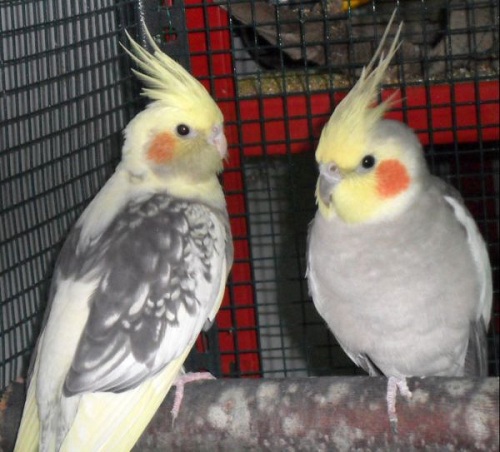 Lixi e Calo
Lixi e Calo
Although it may seem a big parrot it is really a small parrots for two reasons, the voice is NOT too much loud and the beak is small.
There are other varieties in which the gender is less evident: the lutino color predominantly yellow and white, the cinnamon which has a lighter gray scale, the pearly mutation has white or yellow spots spread over the whole body, the faced white mutation has the white face instead of yellow, then there are the yellow face, pastels, the olive, silver and many others.

Feeding.

The cockatiels are granivores, you use the seed mix for parakeets, or mix of canary seed, oats, sunflower seeds (not recommended by many breeders because it is rich in oils and fats, if it is eaten in very quantity then it can hurt at the liver). They love the the panic and it is good provide them once at the week to supplement their diet.
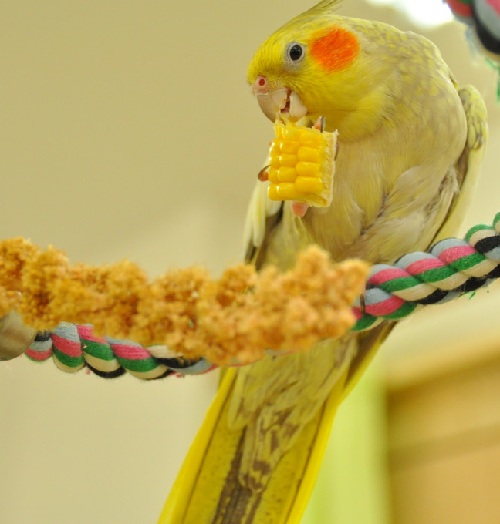
It's necessary to add even more different and alternative food source over the seeds, such as pasta and rice cooked, immature and mature boiled corn, green leafs of vegetables such as cabbage, varieties of salads and green beans, but also other vegetables (carrot, cucumber, peppers and chiles, too spicy, chicory, arugula).
You can provide grassland herbs as well(as Plantago maior and Taraxacum officinalis), they are easy to find in wild gardens and to be supplied after that you have washed them very well.

The fresh fruit is rich in vitamins and minerals (apricot, orange, banana, watermelon, berries, kiwi, tangerine, apple, melon, mulberry, pear, plum, grape).
The legumes are an important source of protein: beans and peas can be provided without to cook them, while the chickpeas and soybeans must be cooked very well. Preferably use organic vegetables, not canned (no in box), dried ones are placed in water for at least 6 hours and then boiled on low heat for about 45 minutes. Soybeans should cook for about 90 minutes.
During the period of feeding you need to add small sprouted seeds , the egg food, small worms,boiled cereals, the hard-boiled egg.
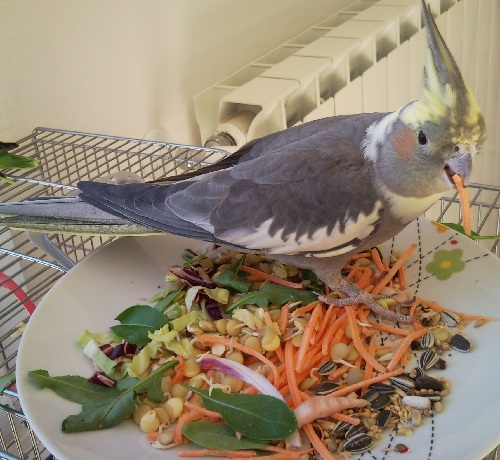
The sprouted seeds are rich in vitamins and they can almost be compared to vegetables. Such as the vitamins E or A and C are multiplied when the grains sprout. They are therefore a very useful food. For the vitamins and their digestibility, these sprouted grains can be donated during the period of breeding and weaning of the offspring. They are very rich in vitamin E and they may be provided before of the breeding season.
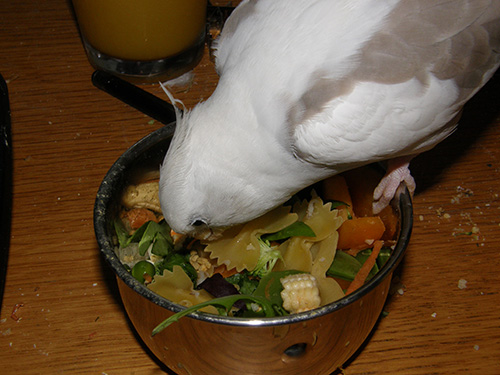
Can be offered in limited quantities: yogurt, cottage cheese, cereal, boiled rice and pasta (preferably wholemeal). The dried fruit (walnuts, almonds, Brazil nuts, cashews, hazelnuts, macadamias, peanuts, pine nuts, pistachios, peanuts) is a good source of protein, fiber, magnesium, zinc, selenium, copper, potassium, phosphorus, biotin, riboflavin, niacin, calcium and vitamin E. It is a healthy and important from a psychological point of view, because parrots are naturally predisposed to open it to extract its contents.
It contains about 50% fat and should be given in moderation.

Are to be avoided: baby formula, the honey: only diluted with water and boiled over low heat for about 30 minutes (for the risk of contamination with spores of botulism).
Parrots should NOT eat: an excess of fatty foods, flavored foods, sugar and jam, fried, foods and beverages that contain caffeine or alcohol, avocado, persimmon (persimmon), peach pits, plum, apricot, cherry (contain cyanogenic glycosides that are converted into cyanide when swallowed), milk (the birds are not able to digest lactose), shells' eggs (or if disinfected, and then boiled for at least 40 minutes), the green parts of sprouts of potatoes. Even certain types of plants can be harmful to these and many other species of parrots, below is a list of harmful foods: avocado, bay leaves, Clematis, Colocasia, Croton, Dieffenbachia, Digital, spurge, false acacia, philodendron, Phytolacca, Lupin, Lily of the Valley, Oleander, Parsley, castor Bean, Rhododendron, Tobacco, and screw rate of Canada. Some branches of the plants belonging to the family of Prunus (apricot, cherry, peach, plum) are poisonous to them. Forbidden chocolate potentially fatal.
Unfortunately the cockatiels do not eat so many foods. You may get them used to a healthy diet, for this reason you have to provide available various types of food after the weaning. His curiosity will take him to taste a bit 'of everything and accept what is it offered as a food acceptable.
Life

In captivity they live about 15 /20 years, although sometimes they live about 10-15 years. There have been reports of individuals who lived more than 30 years, said the older has lived over 35.
Like for a man, diet and exercise are often the main factors that determine the lasted of their lifes.
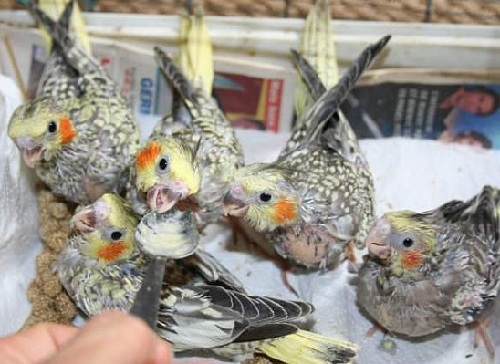
Reproduction

In nature they reproduce themselves after the rainy season, inside the cavity of the eucalyptus trees, where the female lays 5 to 7 white eggs that she hatching with the help of the male. The incubation (hatching) takes about 18/21 days. During the day the male is responsible for hatching while, the night, this task is carried by the female. The chicks leave the nest after about 5 weeks but still depend on their parents for another 2 weeks. In captivity it is not difficult.
It's not request special food for feeding their offspring, because like all parrots through the glands located under the neck, producing a viscous secretion known as "bird's milk". The couple will tend to continue to reproduce throughout the year if the pair is in optimal conditions, but do not exceed 2 or 3 hatched per year to make sure that they don't get sick.

The nest should be of right size: there are some nests that are taller than wide and others that are wider than tall. As far the nests that develop themselves in hight should be 30/40cm high, with a base of at least 20x20 cm with an entry hole with a diameter of 7 cm and the roof openable.
It is important to include an adequate layer of wood chips to wrap the egg lightly.
The young are fed by both parents and usually leave the nest around 3 / 4 weeks of life.
Despite the little ones are not able to eat, the male will continue to feed them for a short period until they reach full autonomy..
Habitat

they are native only to Australia where they are mostly in arid or semi-arid regions of the country, but they live always near to water. they move themselves together in a great group visible at great distances, and when they find a land full of food then they stop there for a while but then they resume their travel. It's possible to see a pairs or small groups, sometimes there are hundreds of flocks around a single water source. They are absent in the most fertile land in the south-west and south-east of the country, in the deserts of Western Australia and Cape York Peninsula. They are the only species of the cockatoo family that reproduce themselves at the end of the first year.
Captivity

The cockatiels are not captured in nature anymore so it is not necessary the CITES for breeding them.
They suffer to live alone therefore it's necessary to breed them in pair. Place the cage in a room of the house in which they have a chance to see other people will bring out the quiet and docile nature that is an feature of their behavior.
It is now the specie more bred after the budgie. It has the same size of a large pigeon; They adapt themselves to live into home very well, in some cases they become very sociable, his voice is a chatter, but it depends by his mood (fear, aggression).
The breeding of these birds is advisable for the breeders that have little experience. These birds are intelligent, curious, you can teach them some little exercise of skill or repeat some words, It is highly bond to whoever takes care and it loves to participate in everyday life.

MUTATIONS (from the site: www.animalinelmondo.it/topic/18876-mutazioni-calopsitta/)
Color In Cockatiels
The color in Cockatiels is derived from two pigments:
Melanin - Provides the Grey color in Normals. It is also present in the eyes, beak, and feet. You will notice some cockatiels have darker beaks and feet than others. The Lutino mutation occurs because of a complete lack of melanin. This is why the eyes appear red, from the blood vessels showing, and the feet and beak to be lighter. Melanin is the stronger color and overrides Lipochromes when both are present.
Lipochromes - These provide the yellow on the face and tail and orange seen in the cheek patch. As males mature the melanin pigments in the face become weaker allowing the Lipochromes to be visable while in the tail the melanin increases in the tail make the tail more of a solid color. The Whiteface Cockatiel lacks Lipochromes, hence the white face with no yellow or orange present which are replaced by white.

Dominant mutations
Dominant mutations are unique in that it requires only one of the parents to produce the mutation in their offspring. For example if you have a Dominant Yellow Cheek hen you will get a percentage of either male and/or female Dominant Yellow Cheek babies. For Sex-linked Yellow Cheek you must have Sex-Linked Yellow Cheek in both the male and female to get male Sex-Linked Yellow Cheek babies. A bird cannot be split to a dominant mutation. You either see it or you don't. A single factor dominant bird has one X chromosome containing the mutation. A double factor dominant has two X chromosomes, hence only males can be double factor.
Dominant Silver
Dominant Silver is a mutation that is dominant to other mutations to produce a silver or light grey. The most obvious difference between the Dominant and the Recessive is the the Dominant has dark eyes verses the red eyes of the recessive. The birds can carry the dominant gene on one or both chromosomes, with the coloring effect being more pronounced in double-factored birds. When the dominant silver gene is carried on one chromosome, it is single-factored and the single factored is darker. When Dominant Silver gene carried on both chromosomes, it is double-factored and is a lighter grey.
Dominant Yellow Cheek
The Dominant Yellow Cheek is very similar to the Sex-Linked Yellow Cheek. Personal observations of the ones I have seen is that the Dominant Yellow Cheeks has a slight orange tinge, possibly due to a double factor, to it but lighter than the yellow-orange of a Pastel's cheek patch. Single factor cheek patches are yellow.
Normal Grey
The Normal Grey is the what all other mutations are derived from and is the Normal Grey Cockatiel seen in the wilds of Australia. The male Normal Grey has dark grey feathers over his entire body, excluding the white wing bars, yellow face, and bright orange cheek patches. Young Normal Grey Cockatiels of both sexes look a lot like female Normal Greys. The face is Grey with dull orange cheek patches along with tail feathers that have a white or yellow barring on the underside. If you see a few white or yellow feathers on the back of your normal grey cockatiel's neck and head, sometimes called ticking, that it means that your cockatiel is split to the recessive mutation Pied.
Diluted
Yellow cheek dominant
Normal grey
 male
male
 female
female
Recessive mutations
To obtain a Recessive mutation baby both parents must have the mutation either visually or split. Hens can be split to a Recessive mutation. Hens cannot be split to a sex-linked mutation. For example to produce Whiteface offspring each parent must at a minimum be split to Whiteface. If one parent contains no Whiteface genes roughly have the offspring will be split to Whiteface but none will visually show it.
Pied
Pieds are basically when the standard body colors are replaced with Yellow or White in varying degrees. When Pieds are judged the degree of symmetry and clarity of markings is important. Ideally, a desirable pied will carry a clear mask, free from extraneous grey or cinnamon feathers or bleeding from the orange cheek patch, clear tail and wing flights and a perfect balance of markings. A pied with dark feathers in the face is called a dirty faced pied. Pieds are also known to have thicker feathering over the body also. Pied occurs because the levels of melanin are different over the feathers of the bird. It has also been noted that Pieds have a thicker set of feathers which is noticeable in young birds as they feather up.
Pieds appear in three ways:
The Light Pied is where most of the bird will be Grey or Cinnamon but some areas of the body are yellow, or white for Whiteface Pieds.
The Heavy Pied is mostly a Yellow or White bird with Grey or Cinnamon still seen on some of the chest and back. The nicest are when the chest and face are clear of the darker colors. Some people also call cockatiels with very little Grey or Cinnamon a Reverse Pied.
The Clear Pied looks much like the Lutino but has dark or normally colored eyes and feet. You may see one or two dark feathers on the back. These can be easily confused with Lutinos and are not as common. They have the advantage of not having the bald spot that has occurs with Lutinos.
Whiteface
Charcoal grey in color, lacking the orange cheek patch and yellow pigment. The whiteface is lacks all lipochrome pigments. Mature adult males will carry a white face as opposed to the yellow mask worn by other varieties. Some of the nicest combinations are the Whiteface Pearl, Whiteface Cinnamon Pearl, Whiteface Pieds and Whiteface Cinnamon Pieds.
Fallow
A brownish (or light cinnamon) appearance resembling the cinnamon, but with a more pronounced yellow suffusion and red eyes due to less melanin. The Fallow cockatiel has a very similar coloration to that of the Cinnamon cockatiel, but with a slightly diluted depth of color. The fallow has red eyes, a pink beak, and pink feet.
Pastel
Pastel is a rather subtle mutation that is rather appropriately named. The pastel mutation can be combined with just about any other mutation with some beautiful results. Pastel cockatiels look just like their normal counterpart, but the yellows, oranges, browns and grays are softened a bit. Hence the name, pastel. The most obvious difference is the orange cheek patch becomes a yellow-orange.
Emerald
It is also called Olive, Spangled or Suffused Yellow. This mutation is hard to describe and has to be seen. The term Emerald or Olive is a bit misleading though. Cockatiels do not carry any green pigmentation, so they can't really be green. The combinations of yellow and greys along with the right lighting make these birds sometimes look green. It can best be described as a mottled or combination of small areas with different colors varying from yellows to greys.
Recessive Silver
The Recessive Silver mutation is a diluted or silvery grey version of the normal grey. The Silver has red eyes, a pink beak, and pink feet. Male Silver cockatiels often have a very deep yellow face and bright orange Cheek Patches at maturity. Female Silver cockatiels will retain their immature coloration and the barring of the underside of the tail.
Pied
 Cassiopea
Cassiopea

White face
Some of the most beautiful combinations are: Pearl White Face, Cinnamon Pearl White Face, Cinnamon Pied and Pied White Face White Face.
 male
male
 female
female
 silver male
silver male
 spangle male
spangle male
Fallow

Pastel
 pastel silver
pastel silver
 pastel silver
pastel silver
Spangle


Sex-linked mutations
Sex linked mutations are carried on the X chromosomes. Cocks have 2 X chromosomes and while Hens have an X and a Y chromosome. Sex-Linked mutations must be carried on both X for cocks, and the single X on Hens, for a mutation to be visible. Hens cannot be split to Sex-Linked mutations because if the mutation is on their X chromosome then it is visible. So, what you see is what you get with Sex-Linked mutations on hens. A male is split when only one X chromosome carries the Sex-Linked mutation.
Lutino
The Lutino is a white bird with an orange cheek patch, some yellow pigment, pink feet and red eyes. Some individuals vary with a light to heavy yellow wash over part or most of the body. Sometimes baldness occurs behind the crest. This occured during the development of this mutation. Your ideal Lutino has no bald
spot. It is very hard to distinguish mature cocks from hens. A common combination is the Lutino Pearl Hen where you find Yellow Pearling over the wings and back.
Cinnamon
The Cinnamon gets it name from it's Cinnamon color which is has been described as a brownish grey or cocoa color. You should not see any Grey and can notice a yellowish tinge to the feathers. The Grey color in a Normal is produced by the melanin pigment which is reduced in the Cinnamon. Some hens may have more yellow, lipochrome pigment, on the face than their Normal Grey counterparts.
The male Cinnamon Cockatiel develops a bright yellow face (also know as the mask) and bright orange cheek patches after it's first molt. Young and female Cinnamon cockatiels retain their dull orange cheek patches, their faces do not turn yellow, and they have white or yellow barring on the underside of their tails.
Pearl
The Pearling are lacings or pearl spots of Yellow or White on the backs, nape, and wings. Yellow Pearls are sometimes called Golden Pearls. White pearling is sometimes called Silver Pearl. Pearling in a Whiteface is always white. The lacings should be extensive and consistent. Small yellow or white marks may be on the breast of heavier marked pearls. Typically adult pearl males lose their Pearling after the first molt due to hormonal changes as they mature. There are some who retain some degree of pearling though. A mature male sometimes has very light colored pearling on the grey or cinnamon background.
Yellow Cheek
Yellow Cheek is one of the newer mutations and is unique in that there are Sex-Linked and Dominant versions of this mutation. Where a Normal Grey has an Orange cheek patch, the cheek patch of the Yellow Cheek is Yellow. The cheek patch of the Dominant Yellow Cheek seems to be a little more orange than the Sex-Linked version. When breeding Yellow Cheeks it is important to never breed Dominant with Sex-Linked. It would take years of test breeding to determine what the offspring really are. It is also not recommended to breed Yellow Cheeks with Whiteface.
Platinum
The Platinum is seen in Australia. In general it is a light, smoky grey back, flights and tail, with flights sometimes almost a grey - brown color with an off white colored chest. Flights and tails are typically always a darker color to other feathers. The underside of tail feathers in mature cocks is usually a brown or chocolate color with light colored feet and beak.
Lutino
 Squikky male
Squikky male
 lutino cinnamon pearl
lutino cinnamon pearl
 lutino pearl
lutino pearl
 pied lutino
pied lutino
Cinnamon
 male
male
 female
female
 cinnamon pearl male
cinnamon pearl male
Pearl

 Tsuka male
Tsuka male
 Dally female
Dally female
 pied pearl
pied pearl
Yellow cheek

Platinum

Our pet ...
Nymphicus hollandicus: cockatiel

Condition:

scientific classification
Domain: Eukaryota
Kingdom: Animalia
Subkingdom: Eumetazoa
Superphylum: deuterostome
Phylum: Chordata
Subphylum: Vertebrata
Superclass: tetrapods
Class: Aves
Suborder: Psittaciformes
Family: Cacatuidae
Subfamily: Nymphicinae
Genre: Nymphicus (Wagler, 1832)
Areal: Natural habitat: Australia

The cockatiel cockatiels or (Nymphicus hollandicus Kerr, 1792), is a bird of the family of Cockatoo. It is the only species belonging to the Nymphicus genus.
Description

The dimensions are enough small, between 30 and 32 cm, elongated, with a long tail and forelock typical, ancestral color is mostly dark gray with the exception of the face and the tuft of yellow color with the typical round up to the spot and red cheeks, clear wings with white patch along the outer edge and the tail lighter than the rest of the body, the female is distinguished from the male for the gray color that persists even in the face and the tuft the red spot is slightly smaller and less intense color and tail barred with yellow. The male has more developed and the tuft of yellow (while the female is smaller and gray) as well as the color of the head in the male has the most widespread and abundant yellow.
 Lixi e Calo
Lixi e CaloAlthough it may seem a big parrot it is really a small parrots for two reasons, the voice is NOT too much loud and the beak is small.
There are other varieties in which the gender is less evident: the lutino color predominantly yellow and white, the cinnamon which has a lighter gray scale, the pearly mutation has white or yellow spots spread over the whole body, the faced white mutation has the white face instead of yellow, then there are the yellow face, pastels, the olive, silver and many others.

Feeding.

The cockatiels are granivores, you use the seed mix for parakeets, or mix of canary seed, oats, sunflower seeds (not recommended by many breeders because it is rich in oils and fats, if it is eaten in very quantity then it can hurt at the liver). They love the the panic and it is good provide them once at the week to supplement their diet.

It's necessary to add even more different and alternative food source over the seeds, such as pasta and rice cooked, immature and mature boiled corn, green leafs of vegetables such as cabbage, varieties of salads and green beans, but also other vegetables (carrot, cucumber, peppers and chiles, too spicy, chicory, arugula).
You can provide grassland herbs as well(as Plantago maior and Taraxacum officinalis), they are easy to find in wild gardens and to be supplied after that you have washed them very well.

The fresh fruit is rich in vitamins and minerals (apricot, orange, banana, watermelon, berries, kiwi, tangerine, apple, melon, mulberry, pear, plum, grape).
The legumes are an important source of protein: beans and peas can be provided without to cook them, while the chickpeas and soybeans must be cooked very well. Preferably use organic vegetables, not canned (no in box), dried ones are placed in water for at least 6 hours and then boiled on low heat for about 45 minutes. Soybeans should cook for about 90 minutes.
During the period of feeding you need to add small sprouted seeds , the egg food, small worms,boiled cereals, the hard-boiled egg.

The sprouted seeds are rich in vitamins and they can almost be compared to vegetables. Such as the vitamins E or A and C are multiplied when the grains sprout. They are therefore a very useful food. For the vitamins and their digestibility, these sprouted grains can be donated during the period of breeding and weaning of the offspring. They are very rich in vitamin E and they may be provided before of the breeding season.

Can be offered in limited quantities: yogurt, cottage cheese, cereal, boiled rice and pasta (preferably wholemeal). The dried fruit (walnuts, almonds, Brazil nuts, cashews, hazelnuts, macadamias, peanuts, pine nuts, pistachios, peanuts) is a good source of protein, fiber, magnesium, zinc, selenium, copper, potassium, phosphorus, biotin, riboflavin, niacin, calcium and vitamin E. It is a healthy and important from a psychological point of view, because parrots are naturally predisposed to open it to extract its contents.
It contains about 50% fat and should be given in moderation.

Are to be avoided: baby formula, the honey: only diluted with water and boiled over low heat for about 30 minutes (for the risk of contamination with spores of botulism).
Parrots should NOT eat: an excess of fatty foods, flavored foods, sugar and jam, fried, foods and beverages that contain caffeine or alcohol, avocado, persimmon (persimmon), peach pits, plum, apricot, cherry (contain cyanogenic glycosides that are converted into cyanide when swallowed), milk (the birds are not able to digest lactose), shells' eggs (or if disinfected, and then boiled for at least 40 minutes), the green parts of sprouts of potatoes. Even certain types of plants can be harmful to these and many other species of parrots, below is a list of harmful foods: avocado, bay leaves, Clematis, Colocasia, Croton, Dieffenbachia, Digital, spurge, false acacia, philodendron, Phytolacca, Lupin, Lily of the Valley, Oleander, Parsley, castor Bean, Rhododendron, Tobacco, and screw rate of Canada. Some branches of the plants belonging to the family of Prunus (apricot, cherry, peach, plum) are poisonous to them. Forbidden chocolate potentially fatal.
Unfortunately the cockatiels do not eat so many foods. You may get them used to a healthy diet, for this reason you have to provide available various types of food after the weaning. His curiosity will take him to taste a bit 'of everything and accept what is it offered as a food acceptable.
Life

In captivity they live about 15 /20 years, although sometimes they live about 10-15 years. There have been reports of individuals who lived more than 30 years, said the older has lived over 35.
Like for a man, diet and exercise are often the main factors that determine the lasted of their lifes.

Reproduction

In nature they reproduce themselves after the rainy season, inside the cavity of the eucalyptus trees, where the female lays 5 to 7 white eggs that she hatching with the help of the male. The incubation (hatching) takes about 18/21 days. During the day the male is responsible for hatching while, the night, this task is carried by the female. The chicks leave the nest after about 5 weeks but still depend on their parents for another 2 weeks. In captivity it is not difficult.
It's not request special food for feeding their offspring, because like all parrots through the glands located under the neck, producing a viscous secretion known as "bird's milk". The couple will tend to continue to reproduce throughout the year if the pair is in optimal conditions, but do not exceed 2 or 3 hatched per year to make sure that they don't get sick.

The nest should be of right size: there are some nests that are taller than wide and others that are wider than tall. As far the nests that develop themselves in hight should be 30/40cm high, with a base of at least 20x20 cm with an entry hole with a diameter of 7 cm and the roof openable.
It is important to include an adequate layer of wood chips to wrap the egg lightly.
The young are fed by both parents and usually leave the nest around 3 / 4 weeks of life.
Despite the little ones are not able to eat, the male will continue to feed them for a short period until they reach full autonomy..
Habitat

they are native only to Australia where they are mostly in arid or semi-arid regions of the country, but they live always near to water. they move themselves together in a great group visible at great distances, and when they find a land full of food then they stop there for a while but then they resume their travel. It's possible to see a pairs or small groups, sometimes there are hundreds of flocks around a single water source. They are absent in the most fertile land in the south-west and south-east of the country, in the deserts of Western Australia and Cape York Peninsula. They are the only species of the cockatoo family that reproduce themselves at the end of the first year.
Captivity

The cockatiels are not captured in nature anymore so it is not necessary the CITES for breeding them.
They suffer to live alone therefore it's necessary to breed them in pair. Place the cage in a room of the house in which they have a chance to see other people will bring out the quiet and docile nature that is an feature of their behavior.
It is now the specie more bred after the budgie. It has the same size of a large pigeon; They adapt themselves to live into home very well, in some cases they become very sociable, his voice is a chatter, but it depends by his mood (fear, aggression).
The breeding of these birds is advisable for the breeders that have little experience. These birds are intelligent, curious, you can teach them some little exercise of skill or repeat some words, It is highly bond to whoever takes care and it loves to participate in everyday life.

MUTATIONS (from the site: www.animalinelmondo.it/topic/18876-mutazioni-calopsitta/)
Color In Cockatiels
The color in Cockatiels is derived from two pigments:
Melanin - Provides the Grey color in Normals. It is also present in the eyes, beak, and feet. You will notice some cockatiels have darker beaks and feet than others. The Lutino mutation occurs because of a complete lack of melanin. This is why the eyes appear red, from the blood vessels showing, and the feet and beak to be lighter. Melanin is the stronger color and overrides Lipochromes when both are present.
Lipochromes - These provide the yellow on the face and tail and orange seen in the cheek patch. As males mature the melanin pigments in the face become weaker allowing the Lipochromes to be visable while in the tail the melanin increases in the tail make the tail more of a solid color. The Whiteface Cockatiel lacks Lipochromes, hence the white face with no yellow or orange present which are replaced by white.

Dominant mutations
Dominant mutations are unique in that it requires only one of the parents to produce the mutation in their offspring. For example if you have a Dominant Yellow Cheek hen you will get a percentage of either male and/or female Dominant Yellow Cheek babies. For Sex-linked Yellow Cheek you must have Sex-Linked Yellow Cheek in both the male and female to get male Sex-Linked Yellow Cheek babies. A bird cannot be split to a dominant mutation. You either see it or you don't. A single factor dominant bird has one X chromosome containing the mutation. A double factor dominant has two X chromosomes, hence only males can be double factor.
Dominant Silver
Dominant Silver is a mutation that is dominant to other mutations to produce a silver or light grey. The most obvious difference between the Dominant and the Recessive is the the Dominant has dark eyes verses the red eyes of the recessive. The birds can carry the dominant gene on one or both chromosomes, with the coloring effect being more pronounced in double-factored birds. When the dominant silver gene is carried on one chromosome, it is single-factored and the single factored is darker. When Dominant Silver gene carried on both chromosomes, it is double-factored and is a lighter grey.
Dominant Yellow Cheek
The Dominant Yellow Cheek is very similar to the Sex-Linked Yellow Cheek. Personal observations of the ones I have seen is that the Dominant Yellow Cheeks has a slight orange tinge, possibly due to a double factor, to it but lighter than the yellow-orange of a Pastel's cheek patch. Single factor cheek patches are yellow.
Normal Grey
The Normal Grey is the what all other mutations are derived from and is the Normal Grey Cockatiel seen in the wilds of Australia. The male Normal Grey has dark grey feathers over his entire body, excluding the white wing bars, yellow face, and bright orange cheek patches. Young Normal Grey Cockatiels of both sexes look a lot like female Normal Greys. The face is Grey with dull orange cheek patches along with tail feathers that have a white or yellow barring on the underside. If you see a few white or yellow feathers on the back of your normal grey cockatiel's neck and head, sometimes called ticking, that it means that your cockatiel is split to the recessive mutation Pied.
Diluted
Yellow cheek dominant
Normal grey
 male
male female
femaleRecessive mutations
To obtain a Recessive mutation baby both parents must have the mutation either visually or split. Hens can be split to a Recessive mutation. Hens cannot be split to a sex-linked mutation. For example to produce Whiteface offspring each parent must at a minimum be split to Whiteface. If one parent contains no Whiteface genes roughly have the offspring will be split to Whiteface but none will visually show it.
Pied
Pieds are basically when the standard body colors are replaced with Yellow or White in varying degrees. When Pieds are judged the degree of symmetry and clarity of markings is important. Ideally, a desirable pied will carry a clear mask, free from extraneous grey or cinnamon feathers or bleeding from the orange cheek patch, clear tail and wing flights and a perfect balance of markings. A pied with dark feathers in the face is called a dirty faced pied. Pieds are also known to have thicker feathering over the body also. Pied occurs because the levels of melanin are different over the feathers of the bird. It has also been noted that Pieds have a thicker set of feathers which is noticeable in young birds as they feather up.
Pieds appear in three ways:
The Light Pied is where most of the bird will be Grey or Cinnamon but some areas of the body are yellow, or white for Whiteface Pieds.
The Heavy Pied is mostly a Yellow or White bird with Grey or Cinnamon still seen on some of the chest and back. The nicest are when the chest and face are clear of the darker colors. Some people also call cockatiels with very little Grey or Cinnamon a Reverse Pied.
The Clear Pied looks much like the Lutino but has dark or normally colored eyes and feet. You may see one or two dark feathers on the back. These can be easily confused with Lutinos and are not as common. They have the advantage of not having the bald spot that has occurs with Lutinos.
Whiteface
Charcoal grey in color, lacking the orange cheek patch and yellow pigment. The whiteface is lacks all lipochrome pigments. Mature adult males will carry a white face as opposed to the yellow mask worn by other varieties. Some of the nicest combinations are the Whiteface Pearl, Whiteface Cinnamon Pearl, Whiteface Pieds and Whiteface Cinnamon Pieds.
Fallow
A brownish (or light cinnamon) appearance resembling the cinnamon, but with a more pronounced yellow suffusion and red eyes due to less melanin. The Fallow cockatiel has a very similar coloration to that of the Cinnamon cockatiel, but with a slightly diluted depth of color. The fallow has red eyes, a pink beak, and pink feet.
Pastel
Pastel is a rather subtle mutation that is rather appropriately named. The pastel mutation can be combined with just about any other mutation with some beautiful results. Pastel cockatiels look just like their normal counterpart, but the yellows, oranges, browns and grays are softened a bit. Hence the name, pastel. The most obvious difference is the orange cheek patch becomes a yellow-orange.
Emerald
It is also called Olive, Spangled or Suffused Yellow. This mutation is hard to describe and has to be seen. The term Emerald or Olive is a bit misleading though. Cockatiels do not carry any green pigmentation, so they can't really be green. The combinations of yellow and greys along with the right lighting make these birds sometimes look green. It can best be described as a mottled or combination of small areas with different colors varying from yellows to greys.
Recessive Silver
The Recessive Silver mutation is a diluted or silvery grey version of the normal grey. The Silver has red eyes, a pink beak, and pink feet. Male Silver cockatiels often have a very deep yellow face and bright orange Cheek Patches at maturity. Female Silver cockatiels will retain their immature coloration and the barring of the underside of the tail.
Pied
 Cassiopea
Cassiopea
White face
Some of the most beautiful combinations are: Pearl White Face, Cinnamon Pearl White Face, Cinnamon Pied and Pied White Face White Face.
 male
male female
female silver male
silver male spangle male
spangle maleFallow

Pastel
 pastel silver
pastel silver pastel silver
pastel silverSpangle


Sex-linked mutations
Sex linked mutations are carried on the X chromosomes. Cocks have 2 X chromosomes and while Hens have an X and a Y chromosome. Sex-Linked mutations must be carried on both X for cocks, and the single X on Hens, for a mutation to be visible. Hens cannot be split to Sex-Linked mutations because if the mutation is on their X chromosome then it is visible. So, what you see is what you get with Sex-Linked mutations on hens. A male is split when only one X chromosome carries the Sex-Linked mutation.
Lutino
The Lutino is a white bird with an orange cheek patch, some yellow pigment, pink feet and red eyes. Some individuals vary with a light to heavy yellow wash over part or most of the body. Sometimes baldness occurs behind the crest. This occured during the development of this mutation. Your ideal Lutino has no bald
spot. It is very hard to distinguish mature cocks from hens. A common combination is the Lutino Pearl Hen where you find Yellow Pearling over the wings and back.
Cinnamon
The Cinnamon gets it name from it's Cinnamon color which is has been described as a brownish grey or cocoa color. You should not see any Grey and can notice a yellowish tinge to the feathers. The Grey color in a Normal is produced by the melanin pigment which is reduced in the Cinnamon. Some hens may have more yellow, lipochrome pigment, on the face than their Normal Grey counterparts.
The male Cinnamon Cockatiel develops a bright yellow face (also know as the mask) and bright orange cheek patches after it's first molt. Young and female Cinnamon cockatiels retain their dull orange cheek patches, their faces do not turn yellow, and they have white or yellow barring on the underside of their tails.
Pearl
The Pearling are lacings or pearl spots of Yellow or White on the backs, nape, and wings. Yellow Pearls are sometimes called Golden Pearls. White pearling is sometimes called Silver Pearl. Pearling in a Whiteface is always white. The lacings should be extensive and consistent. Small yellow or white marks may be on the breast of heavier marked pearls. Typically adult pearl males lose their Pearling after the first molt due to hormonal changes as they mature. There are some who retain some degree of pearling though. A mature male sometimes has very light colored pearling on the grey or cinnamon background.
Yellow Cheek
Yellow Cheek is one of the newer mutations and is unique in that there are Sex-Linked and Dominant versions of this mutation. Where a Normal Grey has an Orange cheek patch, the cheek patch of the Yellow Cheek is Yellow. The cheek patch of the Dominant Yellow Cheek seems to be a little more orange than the Sex-Linked version. When breeding Yellow Cheeks it is important to never breed Dominant with Sex-Linked. It would take years of test breeding to determine what the offspring really are. It is also not recommended to breed Yellow Cheeks with Whiteface.
Platinum
The Platinum is seen in Australia. In general it is a light, smoky grey back, flights and tail, with flights sometimes almost a grey - brown color with an off white colored chest. Flights and tails are typically always a darker color to other feathers. The underside of tail feathers in mature cocks is usually a brown or chocolate color with light colored feet and beak.
Lutino
 Squikky male
Squikky male lutino cinnamon pearl
lutino cinnamon pearl lutino pearl
lutino pearl pied lutino
pied lutinoCinnamon
 male
male female
female cinnamon pearl male
cinnamon pearl malePearl

 Tsuka male
Tsuka male Dally female
Dally female pied pearl
pied pearlYellow cheek

Platinum

Our pet ...
Last edited by marc on Sat 17 Sep 2011, 11:59; edited 2 times in total
 Re: LA CALOPSITE
Re: LA CALOPSITE
Minchia!!! (si può dire, vero????)
Questa si che è una scheda...
Questa si che è una scheda...

ma-shimo- Emperatore der Forum

-

Numero di messaggi : 1563
Età : 56
Località : ghiffa (VB)
Data d'iscrizione : 2008-12-22
 Re: LA CALOPSITE
Re: LA CALOPSITE
Grazie! 

 Si si può dire
Si si può dire  Stò preparando anche quella sul lori arcob. (che mi piace un sacco per i suoi colori) e quella sul port Island, ma non ho trovato altrettanto materiale
Stò preparando anche quella sul lori arcob. (che mi piace un sacco per i suoi colori) e quella sul port Island, ma non ho trovato altrettanto materiale  con l' aiuto di marc la stiamo traducendo in inglese...
con l' aiuto di marc la stiamo traducendo in inglese...
... avevo realizzato anche questo ... tanto vale che ve lo mostro!!!
... avevo realizzato anche questo ... tanto vale che ve lo mostro!!!

Albi- La Sorcina del Forum

-

Numero di messaggi : 664
Età : 53
Località : Colico (Lecco)
Data d'iscrizione : 2011-01-20
 Mutations
Mutations
Photos are from google search unless stated otherwise
Common Mutations
Normal Grey
Male

Female

Pied (must have at least one pied flight or tail to be considered pied, if a bird has yellow feathers on its head or belly but no pied flights the bird is split pied) Pied can appear in any mutation. a clear pied is an all yellow or all white bird with dark eyes. Lutino pieds or whiteface lutino pieds may have blue-green eyes instead of red.
Albi's light pied hen
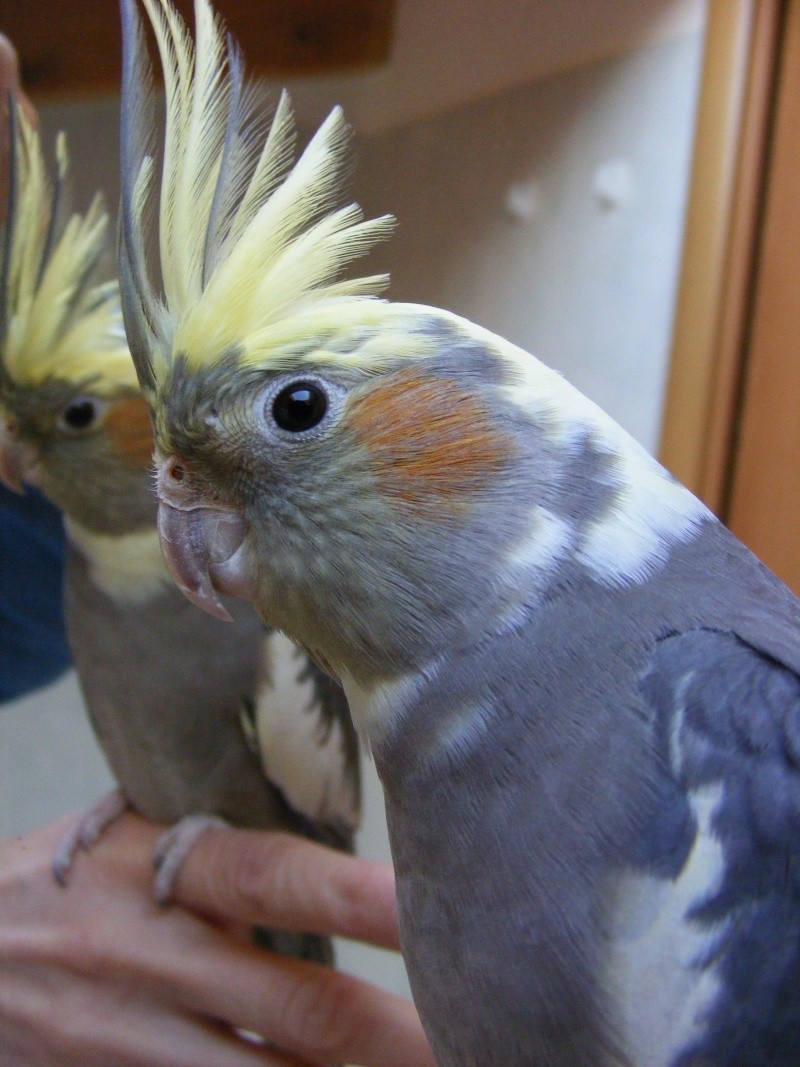
heavy pied

Pearl Pied

Pearl
Male pearls molt out the pearls to look like grey males but they keep some faint pearls and speckling in their tail. Females keep the pearls their whole life.
Male
(My Tsuka)

Mottling in male pearl tail

Female
(My Dally)

Cinnamon
This mutation has a brown or light grey colour to the plumage
Male

Female

Whiteface
There is no red or yellow in whitefaces therefore there is no red cheek and the male gets a white mask instead of yellow
Male

Female

Lutino
(Albi's Lutino)

Lutino Pearl

Lutino Cinnamon Pearl

Lutino Pied
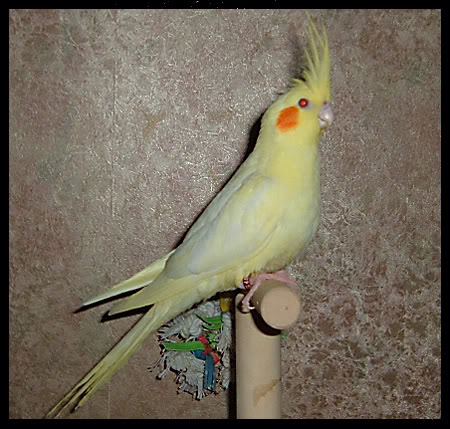
Whiteface Lutino (is not albino, there is no albino cockatiels)

Pastel Face (has a diluted cheek)

Common Mutations
Normal Grey
Male

Female

Pied (must have at least one pied flight or tail to be considered pied, if a bird has yellow feathers on its head or belly but no pied flights the bird is split pied) Pied can appear in any mutation. a clear pied is an all yellow or all white bird with dark eyes. Lutino pieds or whiteface lutino pieds may have blue-green eyes instead of red.
Albi's light pied hen

heavy pied

Pearl Pied

Pearl
Male pearls molt out the pearls to look like grey males but they keep some faint pearls and speckling in their tail. Females keep the pearls their whole life.
Male
(My Tsuka)

Mottling in male pearl tail

Female
(My Dally)

Cinnamon
This mutation has a brown or light grey colour to the plumage
Male

Female

Whiteface
There is no red or yellow in whitefaces therefore there is no red cheek and the male gets a white mask instead of yellow
Male

Female

Lutino
(Albi's Lutino)

Lutino Pearl

Lutino Cinnamon Pearl

Lutino Pied

Whiteface Lutino (is not albino, there is no albino cockatiels)

Pastel Face (has a diluted cheek)


Casey- Admin

-

Numero di messaggi : 274
Età : 32
Località : Ontario, Canada
Data d'iscrizione : 2011-08-07
 Rare Mutations
Rare Mutations
Photos from google search
Yellow Cheek (Cinnamon Pearl male)

Silver (Whiteface male)

Emerald

Fallow

Platinum

Yellow Cheek (Cinnamon Pearl male)

Silver (Whiteface male)

Emerald

Fallow

Platinum


Casey- Admin

-

Numero di messaggi : 274
Età : 32
Località : Ontario, Canada
Data d'iscrizione : 2011-08-07
 Re: LA CALOPSITE
Re: LA CALOPSITE
Casey, you were very good! excellent job!!!!
sei stata molto brava, Casey! ottimo lavoro!!! (non appena riesco le rimpicciolisco e le posto nella scheda...)
quando si dice: L' UNINONE FA' LA FORZA!!!


sei stata molto brava, Casey! ottimo lavoro!!! (non appena riesco le rimpicciolisco e le posto nella scheda...)
quando si dice: L' UNINONE FA' LA FORZA!!!

Albi- La Sorcina del Forum

-

Numero di messaggi : 664
Età : 53
Località : Colico (Lecco)
Data d'iscrizione : 2011-01-20
 Similar topics
Similar topics» calopsite faccia bianca cannella
» LE CALOPSITE
» Calopsite FB
» calopsite palermo
» Allevamento a mano calopsite.
» LE CALOPSITE
» Calopsite FB
» calopsite palermo
» Allevamento a mano calopsite.
Page 1 of 1
Permissions in this forum:
You cannot reply to topics in this forum
 Home
Home